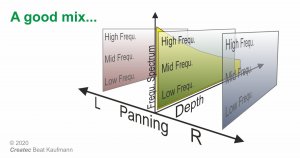Depth typically refers to what you'd call
soundstaging. A stereo mix can be thought of as having 3 axes.
- X = Left to Right - Panning, width, etc.
- Z = Depth - Front-to-back perception. Does one instrument appear to sit behind another?
- Y = Height - Does the stereo image convey a sense of height? Sub and low frequencies are often perceived as low, mid and high frequencies appear at a higher elevation, however panning can have a big impact on the perception of height as well. (This is the axis most often not mentioned or overlooked when discussing 'soundstaging'. I don't know why honestly as it's equally as important... They all work together to create a lush soundstage. That's why my alphabetization is out of order... Y is often not mentioned...)
So basically it seems like you're asking two question but assigning them the same name... Hearing instruments clearly is separation. This is a totally separate discussion from 'depth'. Although they can be related, as if that is confusing enough!
Depth is far and away the more complex of the two. Unlike EQ, where there are tons of tools out there that can quickly 'shortcut' you to a balanced sound, creating depth requires the ability to hear where an existing instrument currently
appears in the Z plane, then determining where you think it should sit. Is it too forward? How far back do you want it to appear and what are the best tools in your toolbox to accomplish this?
The last bit is a big part of what's called
critical listening. (Assuming you're unfamiliar...) The ability to listen to a piece of music and hear each plane... The ability to pick each instrument out of the mix, hear where it's panned, determine what sounds foreground and background. The ability to listen for any impression of the height of the "stage", and notice of some instruments appear to sit higher or lower vertically.
It goes deeper than that, e.g. hearing compression, saturation, etc... But hearing depth and knowing how to create it requires more finesse than you'll get in a simple forum post. Basically, sure you can push something back in a mix with reverb. The question is do the winds appear to sit behind the strings but in front of the timpani?
I'm not trying to answer your question with a question... I'm just saying that while you can learn how to mix you should also be aware that critical listening and mixing go hand in hand... And this particular question requires some pretty solid listening skills.
That said... Kmaster's got great advice about beat's posts. Joel has some great techniques as well... Just be aware that this is one of the more abstract concepts in mixing, quite possibly the one people have the most challenge grasping... So don't overlook the importance of the ability to listen to mixes you know well, then analyze and ask yourself questions about how you perceive their 3-dimensional landscape.






